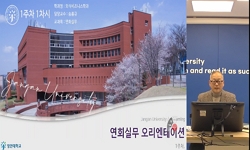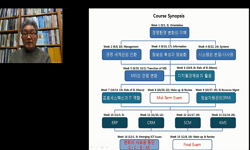While the recent lift of restrictions in greenbelt areas is expected to generate a number of development plans, there are efforts to create various development plans into spatial plans that consider the natural and ecological conditions of development...
http://chineseinput.net/에서 pinyin(병음)방식으로 중국어를 변환할 수 있습니다.
변환된 중국어를 복사하여 사용하시면 됩니다.
- 中文 을 입력하시려면 zhongwen을 입력하시고 space를누르시면됩니다.
- 北京 을 입력하시려면 beijing을 입력하시고 space를 누르시면 됩니다.

개발 예정지역에서의 자연보전 가치 평가 - 대관령 알펜시아 리조트 조성 예정지역을 사례로 - = A Study for Natural Conservation Value Assessment of Developing Area - Case Study of Alpensia Resort -
한글로보기https://www.riss.kr/link?id=A101267382
-
저자
최희선 ; 조동길 ; 박미영 ; 김남균 ; 김귀곤 ; Choi Hee-Sun ; Cho Dong-Gil ; Park Mi-Young ; Kim Nam-Gyun ; Kim Kwi-Gon
- 발행기관
- 학술지명
- 권호사항
-
발행연도
2005
-
작성언어
Korean
- 주제어
-
등재정보
KCI등재
-
자료형태
학술저널
- 발행기관 URL
-
수록면
108-118(11쪽)
-
KCI 피인용횟수
3
- 제공처
- 소장기관
-
0
상세조회 -
0
다운로드
부가정보
다국어 초록 (Multilingual Abstract)
While the recent lift of restrictions in greenbelt areas is expected to generate a number of development plans, there are efforts to create various development plans into spatial plans that consider the natural and ecological conditions of development sites. However, these development plans consider Degree of Green Naturality or Degree of Ecology only when designating areas for conservation within development sites. It is true that they don't fully reflect the value of green areas and wetlands as habitats and natural resources. Therefore, this study built an conservation value assessment model that is applicable to sites where development is planned in Korea by reviewing prior case examples md studies and applied the developed model to a case study area. The site where the conservation value assessment model was applied to is an area around Yongsan-ri and Suha-ri, Doam-myon, Pyeongchang-gun, Gangwon province where quality natural resources are located in and wend the site. This is a site for the development of Alpensia Resort where a resort including facilities for the Winter Olympics is planned to be introduced. In order to assess the conservation value of the site for Alpensia Resort, a total of eight items including area, distribution of communities, habitation of species with conservation value, functions of habitats, connectivity of habitats, vegetation layers of forests, age of forests, and ratio of non-native plants were studied through literature review and field surveys. The assessment was made by dividing the site into 95 habitats that are perceived by aerial photographs and each habitat unit was assessed on the eight items in a 3-point scale. Each unit habitat assessed in a 3-point scale was segmented into primary, secondary or tertiary areas based on the conservation value. Habitats assessed as primary were designated as priority (absolute) conservation areas and those assessed as secondary and tertiary were set as secondary conservation areas and tertiary conservation areas, respectively. As a result, each area represented 26.9%, 20% and 3% of total site area. Based on this result, habitat management plans were developed to conserve primary conservation areas, improve secondary conservation areas and restore tertiary conservation areas. In addition, a development plan was developed to create habitats in areas where new habitats are requested in order to build an eco-network in the site and a plan to create eco-corridors was proposed. In developing a land use plan for the site, a development plan that considers conservation areas first should be set up based on the outcome of conservation value assessment. This can be linked to the development of an environment-friendly land use plan as well as easing the establishment of a green area and eco-network. This study will facilitate the implementation of the 'conservation before development' principle, which can prevent reckless development, by assessing conservation value in setting up development plans.
참고문헌 (Reference)
1 "파주운정 2지구 택지개발예정지구 사전 환경성 검토서" 대한주택공사 2003a
2 "청주 율량지구 택지개발 예정지구 사전환경성 검토서" 한국토지공사 2003a
3 "청주 성화 2지구 택지개발예정지구 사전 환경성 검토서" 대한주택공사 2003b
4 "자연환경ㆍ생태복원학 원론" 서울 아카데미서적 2004
5 "자연자원의 평가를 중심으로 한 자연환경감사의 적용 파주시 민통지역 및 비무장지대를 대상으로" 2000
6 "인공위성 영상자료와 GIS를 이용한 녹지자연도 등급판정 기법 개발" 환경부 2-3, 1998
7 "습지와 환경" 아카데미 서적 173-196, 2002
8 "수원 호매실지구 택지개발 예정지구 사전환경성 검토서" 대한주택공사 2004
9 "서울 신내 2지구 택지개발 예정지구 사전환경성 검토서" SH공사 2004
10 "생태ㆍ자연도작성지침" 환경부 2004
1 "파주운정 2지구 택지개발예정지구 사전 환경성 검토서" 대한주택공사 2003a
2 "청주 율량지구 택지개발 예정지구 사전환경성 검토서" 한국토지공사 2003a
3 "청주 성화 2지구 택지개발예정지구 사전 환경성 검토서" 대한주택공사 2003b
4 "자연환경ㆍ생태복원학 원론" 서울 아카데미서적 2004
5 "자연자원의 평가를 중심으로 한 자연환경감사의 적용 파주시 민통지역 및 비무장지대를 대상으로" 2000
6 "인공위성 영상자료와 GIS를 이용한 녹지자연도 등급판정 기법 개발" 환경부 2-3, 1998
7 "습지와 환경" 아카데미 서적 173-196, 2002
8 "수원 호매실지구 택지개발 예정지구 사전환경성 검토서" 대한주택공사 2004
9 "서울 신내 2지구 택지개발 예정지구 사전환경성 검토서" SH공사 2004
10 "생태ㆍ자연도작성지침" 환경부 2004
11 "보전성을 중심으로 한 토지적성 평가 개선 방법에 관한 연구" 2003
12 "도시지역의 생태자원 보전을 위한 평가모형 개발" 2002
13 "김포 양촌지구 택지개발 예정지구 사전환경성 검토서" 한국토지공사 2003b
14 "강원도개발공사 대관령 알펜시아 리조트 조성사업에 따른 사전환경성검토서" 2004
15 "Wildlife Reserves and Corridors in the Urban Environment a Guild to Ecological Landscppe Planning and Resource Conservation National Institute for Urban Wildlife" 1989
16 "University of Minnesota Press" 1994
17 "The Planning and Management of Environmentally Sensitive Area" Longman Inc 45-46, 1984
18 "The Green Encyclopedia" New York A Simon & Schuster Macmillan Company 1992
19 "Nature Conservation Objectives in Shoreline Management Plan 'Suggested Approach'" 1997
20 "Map of ecological networks for landscape planning" 157-170, 2002
21 "Managing Habitats for Conservation" Cambridge University Press 25 59-28 83, 1995
22 "Management Recommendations for Washington's Priority Species IV Wasington Department of Fish and Wildlife" 1999
23 "Leeds Metropolitan University Faculty of Design & Built Environment School of Art" a (a): 1997-98
24 "Landscape Planning and Ecological Networks" 1-11, 1994
25 "Handbook for Phase 1 Habitat Survey-a Technique for Environmental Audit" 1990
26 "Handbook for Phase 1 Habitat Survey a Technique for Environmental Audit" 1990
27 "Guidelines for Marine Protected Areas" 1999
28 "Forest Fragmentation: Wildlife and Management Implications" 25-47, 1998
29 "Evaluation and Assessment for Conservation Ecological Guidelines for Determining Priorities for Natural Conservation" 1992
30 "Effects of English Ivy Invasions on Forested Plant Communities in Pacific Northwest Urban Parks University of Washington" Honors Thesis. University of Washington. ho (ho): 1998
31 "Ecosystem Classification for Environmental Management" Kluwer Academic Publishers 1994
32 "Criteria and Procedure for Identifying Nature Conservation Site in London Ecology Unit" 1994
33 "City of Redmond Draft Wildlife Habitat Plan" 2000
34 "Characteristics of urban woodlands affecting breeding bird diversity and abundance" 481-495, 1987
35 "An assessment of conservation value within a large site of special scientific interest in North Yorkshire" 323-348, 1980
36 "An assessment of conservation value within a large site of special scientific interest in North Yorkshire" 323-348, 1980
동일학술지(권/호) 다른 논문
-
고개의 조망특성에 관한 연구 - 부산광역시를 대상으로 -
- 한국조경학회
- 강영조
- 2005
- KCI등재
-
- 한국조경학회
- 안계복
- 2005
- KCI등재
-
경관 생태 연구의 새로운 방법론 모색을 통한 도입 가능성과 한계성
- 한국조경학회
- 나정화
- 2005
- KCI등재
-
- 한국조경학회
- 황보철
- 2005
- KCI등재
분석정보
인용정보 인용지수 설명보기
학술지 이력
| 연월일 | 이력구분 | 이력상세 | 등재구분 |
|---|---|---|---|
| 2020 | 평가예정 | 계속평가 신청대상 (등재유지) | |
| 2015-01-01 | 평가 | 우수등재학술지 선정 (계속평가) | |
| 2011-01-01 | 평가 | 등재학술지 유지 (등재유지) |  |
| 2009-01-01 | 평가 | 등재학술지 유지 (등재유지) |  |
| 2007-01-01 | 평가 | 등재학술지 유지 (등재유지) |  |
| 2005-05-20 | 학술지명변경 | 외국어명 : 미등록 -> Journal of the Korean Institute of Landscape Architecture |  |
| 2005-01-01 | 평가 | 등재학술지 유지 (등재유지) |  |
| 2002-07-01 | 평가 | 등재학술지 선정 (등재후보2차) |  |
| 2000-01-01 | 평가 | 등재후보학술지 선정 (신규평가) |  |
학술지 인용정보
| 기준연도 | WOS-KCI 통합IF(2년) | KCIF(2년) | KCIF(3년) |
|---|---|---|---|
| 2016 | 0.74 | 0.74 | 0.78 |
| KCIF(4년) | KCIF(5년) | 중심성지수(3년) | 즉시성지수 |
| 0.76 | 0.74 | 1.022 | 0.14 |




 ScienceON
ScienceON







